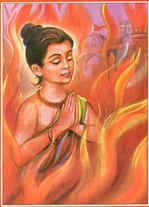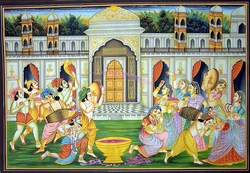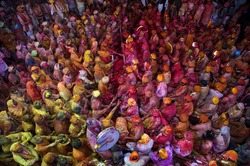Holi ( ???? in Sanskrit; pronounced almost like the English word holy), sometimes called Hinduism’s “Festival of Colors,” is about as joyous as a religious holiday can be. Although other rituals mark the observance, the highlight is throwing colored powder and colored water at each other. Class distinctions, skin color, age, and gender — all that usually separates us seem to fade away as everyone becomes covered by the same multi-colored mess.
 There are different stories explaining the origins of the holiday. For many Hindus, the day is a celebration of the triumph of the child devotee Prahlad, whose staunch devotion to Lord Vishnu infuriated his demon father Hiranyakashipu. In spite of several threats from Hiranyakashipu, Prahlad refused to give up his faith. This was more than the tyrant Hiranyakashipu could bear, and so he tried in various ways to have Prahlad killed — poison, mad elephants, poisonous snakes. Each attempt failed, Prahlad’s unflinching faith impelling Vishnu to protect him. Finally, Hiranyakashipu ordered young Prahlad to sit in the lap of his sister, a demoness named Holika who had acquired a mystic shawl that would protect her from fire. The obedient Prahlad complied, and the boy and his aunt were set ablaze. Miraculously, the shawl flew off of Holika, who then
There are different stories explaining the origins of the holiday. For many Hindus, the day is a celebration of the triumph of the child devotee Prahlad, whose staunch devotion to Lord Vishnu infuriated his demon father Hiranyakashipu. In spite of several threats from Hiranyakashipu, Prahlad refused to give up his faith. This was more than the tyrant Hiranyakashipu could bear, and so he tried in various ways to have Prahlad killed — poison, mad elephants, poisonous snakes. Each attempt failed, Prahlad’s unflinching faith impelling Vishnu to protect him. Finally, Hiranyakashipu ordered young Prahlad to sit in the lap of his sister, a demoness named Holika who had acquired a mystic shawl that would protect her from fire. The obedient Prahlad complied, and the boy and his aunt were set ablaze. Miraculously, the shawl flew off of Holika, who then
was burnt to death, and covered Prahlad, who survived unharmed. Holi is said to mark the the burning of Holika.
But perhaps there is no place where Holi is more vibrant, more
exciting, and more reveled in than in Braj (also known as Vrindavan),
the childhood home of Lord Krishna.

In Braj, Holi is not a one-day event– it is two-weeks of festivities
culminating in two days of joyful “color wars” between the men and
women of Lord Krishna and his beloved Radha’s followers. One legend —
popular among the people of Braj, but not found in traditional Hindu
texts — is that the blackish colored Krishna is said to have
complained to his mother about the
contrast between his dark skin and Radha’s golden complexion. Krishna’s
mother Yashoda Ma playfully pacified her divine son by telling him to
apply color to Radha’s face. And so Lord Krishna decided that this was
a good opportunity to play pranks on all the cowherd girls and leave
them covered in so many colors that they’d end up the same hue as he.
(As an aside, Yashoda’s advice seems to have been
spot-on; having played Holi in India, I can attest to the fact that
once all the colors mix together on a person’s face they look
unmistakably bluish-black — the exact color that Krishna is described to be!)
To
this day, Holi in Braj remains an occasion for a good-natured “war of the
sexes.” In one popular tradition, the men from Nandagaon (Krishna’s
village) attempt to follow in Krishna’s footsteps and douse the women
of Barsana (Radha’s village). The women, however, chase the men away
with long sticks called lathis. The men are forbidden from
striking the women back, so their only recourse is to protect
themselves with shields and try to throw as much color as they can.
The whole time, of course, everyone is shouting the battle cries of Jai Radhe or Jai Sri Krishna.

If all of this seems a bit silly and maybe even a little childish,
well, it should. Holi is one of those rare holidays where gaiety trumps
piety, and where “wearing your faith on your sleeve” takes on a whole
new meaning. It is one day on the Hindu calendar when even the most
uptight and stuffy among the religious folk get down from their
pedestals and join in the fun. It is religion perhaps as it should be
more often… bright, happy, and full of color.

